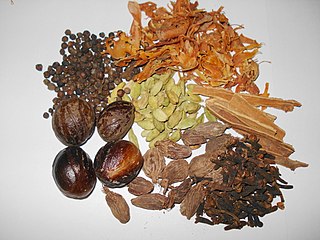
Spice mixes are blended spices or herbs. When a certain combination of herbs or spices is called for in a recipe, it is convenient to blend these ingredients beforehand. Blends such as chili powder, curry powder, herbes de Provence, garlic salt, and other seasoned salts are traditionally sold pre-made by grocers, and sometimes baking blends such as pumpkin pie spice are also available. These spice mixes are also easily made by the home cook for later use.

Aspic or meat jelly is a savory gelatin made with a meat stock or broth, set in a mold to encase other ingredients. These often include pieces of meat, seafood, vegetable, or eggs. Aspic is also sometimes referred to as aspic gelée or aspic jelly. In its simplest form, aspic is essentially a gelatinous version of conventional soup.
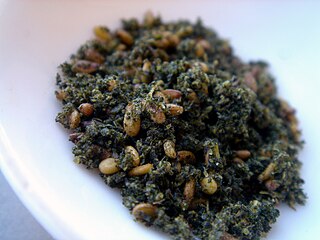
Za'atar is a culinary herb or family of herbs. It is also the name of a spice mixture that includes the herb along with toasted sesame seeds, dried sumac, often salt, as well as other spices. As a family of related Middle Eastern herbs, it contains plants from the genera Origanum (oregano), Calamintha, Thymus, and Satureja (savory) plants. The name za'atar alone most properly applies to Origanum syriacum, considered in biblical scholarship to be the ezov of the Hebrew Bible, often translated as hyssop but distinct from modern Hyssopus officinalis.

Khachapuri is a traditional Georgian dish of cheese-filled bread. The bread is leavened and allowed to rise, molded into various shapes, and then filled in the center with a mixture of cheese, eggs, and other ingredients. The bread crust is traditionally torn off and dipped into the cheese.

A Keipi or festivity supra is a traditional banquet feast in Georgia.
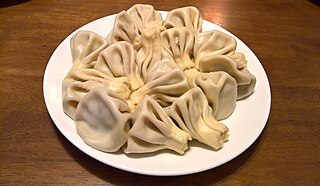
Khinkali is a dumpling in Georgian cuisine. It is made of twisted knobs of dough, stuffed with meat, fish or vegetables and spices.
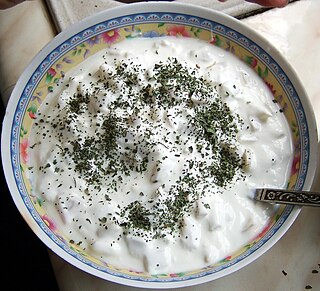
Matzoon or matsoni is a fermented milk product of Armenian origin, distributed in Armenia and Georgia. The so-called Caspian Sea yogurt circulated and commercialized in Japan is sometimes said to be the same type of yogurt as matzoon, but a comparison of microbiota and viscosity found that the two are entirely different.

This is a list of Georgian cheeses. Over 250 varieties of cheese are produced in Georgia.

Churchkhela is a traditional Georgian candle-shaped candy.
Georgian cuisine consists of cooking traditions, techniques, and practices of Georgia. Georgian cuisine has a distinct character, while bearing some similarities with various national cuisines of the Caucasus, the Middle East and Eastern Europe. Every region of Georgia has its own distinct style of food preparation. Eating and drinking are important parts of Georgian culture.
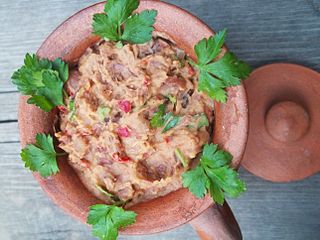
Lobio is a traditional Georgian dish of various kinds of prepared beans, containing coriander, walnuts, garlic and onion. There are many varieties of lobio, both hot and cold.

Tkemali is a Georgian sauce primarily made of cherry plum, sometimes alucha or other varieties of plum. Both red and green varieties of plum are used. The flavor of the sauce varies, but generally tends to be pungently tart. To lower the tartness level, occasionally sweeter types of plums are added during preparation. Traditionally, besides plum the following ingredients are used: garlic, pennyroyal, cumin, coriander, dill, chili pepper and salt.

A supra is a traditional Georgian feast and a part of Georgian social culture. There are two types of supra: a festive supra, called a keipi; and a sombre supra, called a kelekhi, which is always held after burials.
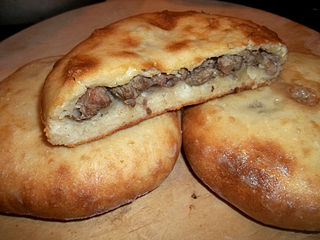
Kubdari or Kubed is a Georgian filled bread dish which is particularly a national dish of the Svans. The bread is leavened and allowed to rise. The filling contains chunks of meat, which can be lamb, kid or pork, Georgian spices and onions. Kubdari was inscribed on the Intangible Cultural Heritage of Georgia list in 2015.
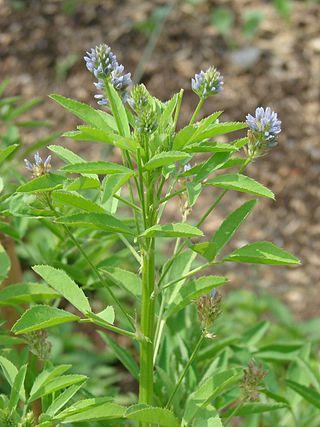
Trigonella caerulea is an annual herb in the family Fabaceae. It is 30–60 cm tall. Its leaves are obovate or lance-shaped, 2–5 cm long, 1–2 cm wide and saw-toothed in upper part. Its flower stalks are compact, globular racemes, longer than the leaves. The sepals are twice as short as the corolla, its teeth are equal to the tube. The corolla is 5.5-6.5 mm long and blue. The pods are erect or slightly curved, compressed, 4–5 mm long with beak 2 mm. The seeds are small and elongated. It blossoms in April–May, the seeds ripen in May–June. It is self-pollinated.

Pkhali is a traditional Georgian dish of chopped and minced vegetables, made of cabbage, eggplant, spinach, beans, beets and combined with ground walnuts, vinegar, onions, garlic, and herbs. Pkhali is also called mkhali. The common ingredient of all variations of pkhali is puréed walnut sauce. In Georgian restaurants, pkhali is usually served in three types: Spinach, beetroot and white beans.

Chkmeruli or Shkmeruli is a traditional Georgian dish of chicken in garlic sauce.
Ispanakhi Matsvnit is a Georgian salad dish composed of cooked and minced spinach mixed with yoghurt. Garlic, salt and cilantro are added as flavouring to the dish while preparing.

















